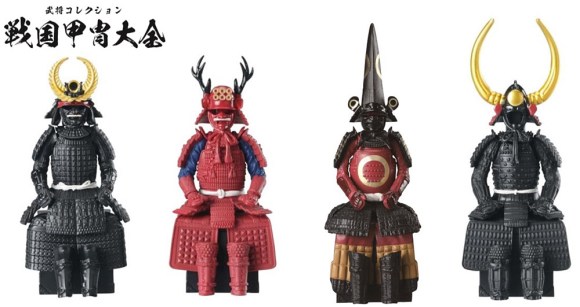
Historically accurate replicas of samurai helmets and armour will soon be coming to vending machines at castles around the country.
Capsule toy vending machines, or gachapon, are filled with all sorts of goodies. From girls wrapped up in sushi to mini folding chairs and tiny coin lockers, you never know what you might find inside one of the plastic modules.
This month, toy and hobby manufacturer Bandai will be miniaturising some of Japan’s most famous military commanders for the toy vending machine market, with a focus on striking warrior helmets and armour. There are four warriors to collect, each with a special gold version, ready to take pride of place on your desk at work or home.
Tokugawa Ieyasu (1543–1616) was a powerful and influential warrior who, in 1603, established the Tokugawa Shogunate, which would rule the country for more than 250 years following the end of the Sengoku Jidai, or Warring States Period of Japan ( c. 1467–c. 1603). The armour of the Tokugawa Family is viewed as “auspicious armour”, due to Ieyasu’s victory in the Battle of Sekigahara in 1600, so if you’re looking for good luck in studies or in business, this is the capsule toy you’re after.
Kuroda Nagamasa (1568–1623) was a prominent military commander known for his distinctive kabuto (helmet), which featured a pair of imposing water buffalo horns. The horned helmet was used as a symbol of reconciliation when Kuroda exchanged it with the helmet of the Lord of the Hiroshima Domain, Fukushima Masanori (c.1561–1624), as a testimony of their friendship after battle. The helmet was returned to the Kuroda family in 1844.
Sanada Yukimura (1567–1615) is enjoying renewed interest in Japan at the moment as the leading character in the 2016 NHK year-long TV drama Sanada Maru. As the leading general on the defending side of the Siege of Osaka, Yukimura’s legend has been retold over the centuries, with the military leader known as the “Crimson Demon of War”, due to his distinctive red armour. His helmet has hand-carved wooden antlers and six Kan’ei Tsuho, copper coins once used for currency, which are also the symbol of the Sanada clan.
Katō Kiyomasa (1561–1611) is known for building Kumamoto Castle, one of Japan’s most esteemed fortresses. Known as a ruthless fighter, Kiyomasa’s battle armour is distinctive, both in its shades of colour and its large bullseye, which is the Katō family crest. Modelled on the eboshi, traditional headdress worn by Shinto Priests, the extra tall naga eboshi helmet shown here was reserved for only top-ranking samurai.
The seven to eight-centimetre- (2.8–3.1 inch-) tall figures will be available for 400 yen (US$3.55) from 18 March at souvenir store gachapon capsule toy vending machines at: Osaka Castle, Kumamoto Castle, Himeji Castle, Hikone Castle, Nijo Castle and Ueda Castle.





 Protect your drinks with Samurai armour bottle covers
Protect your drinks with Samurai armour bottle covers We check out the new Samurai Star Wars figurines from Bandai and Tamashii Nations【Pics】
We check out the new Samurai Star Wars figurines from Bandai and Tamashii Nations【Pics】 Japanese beef bowl chain Sukiya’s 2026 Smile Box lucky bag basically pays for itself
Japanese beef bowl chain Sukiya’s 2026 Smile Box lucky bag basically pays for itself We revisited Sweets Paradise after a decade to see if Japan’s dessert buffet still delivers
We revisited Sweets Paradise after a decade to see if Japan’s dessert buffet still delivers Survey finds more than 70 percent of Japanese children have an online friend
Survey finds more than 70 percent of Japanese children have an online friend What’s it really like to climb Mt Fuji?
What’s it really like to climb Mt Fuji? 7-Eleven Japan’s ramen-cooking robot whipped us up a bowl of noodles【Taste test】
7-Eleven Japan’s ramen-cooking robot whipped us up a bowl of noodles【Taste test】 What’s the best way to spend 1,000 yen at the Seria 100-yen chainstore in Japan?
What’s the best way to spend 1,000 yen at the Seria 100-yen chainstore in Japan? Burgers soaked in a plate of hot cheese served at American Diner Andra in Tokyo
Burgers soaked in a plate of hot cheese served at American Diner Andra in Tokyo Shake Udon one-hand takeout bukkake noodle cups look to shake udon eating in Japan【Taste test】
Shake Udon one-hand takeout bukkake noodle cups look to shake udon eating in Japan【Taste test】 Cup Noodle tries an authentic Jiro-style ramen, but something’s not quite right
Cup Noodle tries an authentic Jiro-style ramen, but something’s not quite right We take a ride on Seibu Railway’s futuristic luxury liner: the Limited Express Laview
We take a ride on Seibu Railway’s futuristic luxury liner: the Limited Express Laview Starbucks Japan ready to get Year of the Horse started with adorable drinkware and plushies【Pics】
Starbucks Japan ready to get Year of the Horse started with adorable drinkware and plushies【Pics】 Hayao Miyazaki says Happy New Year to Studio Ghibli fans with new art for Year of the Horse
Hayao Miyazaki says Happy New Year to Studio Ghibli fans with new art for Year of the Horse 7 great places to see Mt. Fuji from without having to climb it
7 great places to see Mt. Fuji from without having to climb it We found possibly the quietest Japanese-style hotel in Tokyo’s bustling Shinjuku district
We found possibly the quietest Japanese-style hotel in Tokyo’s bustling Shinjuku district Hello Kitty Choco Egg figures are an adorable trip through three periods of Japanese pop culture【Pics】
Hello Kitty Choco Egg figures are an adorable trip through three periods of Japanese pop culture【Pics】 Japan’s oldest largetooth sawfish in captivity back on display in Mie Prefecture
Japan’s oldest largetooth sawfish in captivity back on display in Mie Prefecture Cyberpunk anime meets traditional culture in Ghost in the Shell gold leaf Japanese changing screens
Cyberpunk anime meets traditional culture in Ghost in the Shell gold leaf Japanese changing screens The best Starbucks Japan Frappuccinos we want to drink again in 2026
The best Starbucks Japan Frappuccinos we want to drink again in 2026 7-Eleven Japan starts new temporary luggage storage service in over 300 branches
7-Eleven Japan starts new temporary luggage storage service in over 300 branches Disillusionment at Tsukiji’s tourist-target prices led us to a great ramen restaurant in Tokyo
Disillusionment at Tsukiji’s tourist-target prices led us to a great ramen restaurant in Tokyo Starbucks teams up with 166-year-old Kyoto doll maker for Year of the Horse decorations【Photos】
Starbucks teams up with 166-year-old Kyoto doll maker for Year of the Horse decorations【Photos】 Tokyo considering law requiring more trash cans following litter increase in heavily touristed area
Tokyo considering law requiring more trash cans following litter increase in heavily touristed area Tokyo’s Tsukiji sushi neighborhood asks tour groups to stay away for the rest of the month
Tokyo’s Tsukiji sushi neighborhood asks tour groups to stay away for the rest of the month Tokyo event lets you travel back in time, for free, to celebrate 100 years since Showa era start
Tokyo event lets you travel back in time, for free, to celebrate 100 years since Showa era start Sanrio theme park in Japan announces plans to expand into a Sanrio resort
Sanrio theme park in Japan announces plans to expand into a Sanrio resort Japan may add Japanese language proficiency, lifestyle classes to permanent foreign resident requirements
Japan may add Japanese language proficiency, lifestyle classes to permanent foreign resident requirements Stamina-destroying “Paralysis Noodles” are Tokyo’s newest over-the-top ramen innovation
Stamina-destroying “Paralysis Noodles” are Tokyo’s newest over-the-top ramen innovation Survey asks foreign tourists what bothered them in Japan, more than half gave same answer
Survey asks foreign tourists what bothered them in Japan, more than half gave same answer Japan’s human washing machines will go on sale to general public, demos to be held in Tokyo
Japan’s human washing machines will go on sale to general public, demos to be held in Tokyo Japan’s deadliest food claims more victims, but why do people keep eating it for New Year’s?
Japan’s deadliest food claims more victims, but why do people keep eating it for New Year’s? We deeply regret going into this tunnel on our walk in the mountains of Japan
We deeply regret going into this tunnel on our walk in the mountains of Japan Studio Ghibli releases Kodama forest spirits from Princess Mononoke to light up your home
Studio Ghibli releases Kodama forest spirits from Princess Mononoke to light up your home Major Japanese hotel chain says reservations via overseas booking sites may not be valid
Major Japanese hotel chain says reservations via overseas booking sites may not be valid Put sesame oil in your coffee? Japanese maker says it’s the best way to start your day【Taste test】
Put sesame oil in your coffee? Japanese maker says it’s the best way to start your day【Taste test】 No more using real katana for tourism activities, Japan’s National Police Agency says
No more using real katana for tourism activities, Japan’s National Police Agency says Starbucks Japan reveals new sakura drinkware collection, inspired by evening cherry blossoms
Starbucks Japan reveals new sakura drinkware collection, inspired by evening cherry blossoms Updated cherry blossom forecast shows extra-long sakura season for Japan this year
Updated cherry blossom forecast shows extra-long sakura season for Japan this year
Leave a Reply